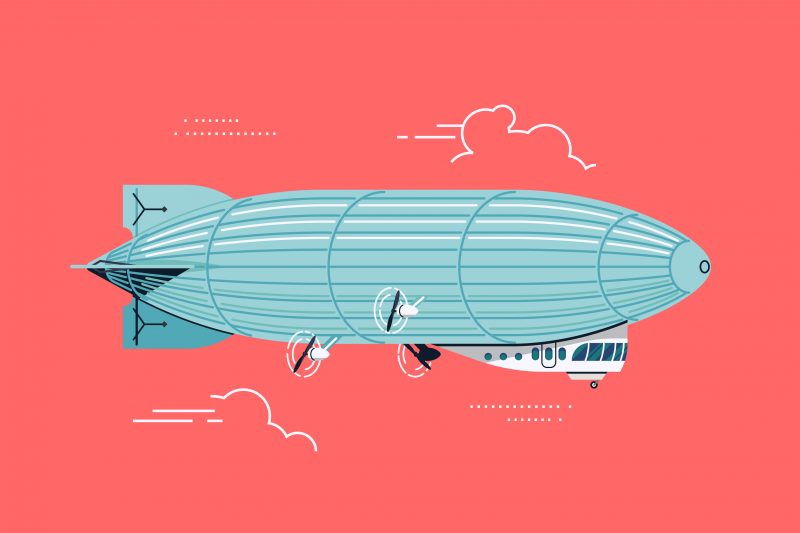When compared to modern jet engine airplanes, airships are admittedly much slower.
But, unlike airplanes, well-engineered airships can carry more cargo, stay in flight for days, and can land and takeoff easily in areas without specialized infrastructure.
They are also less dependent on traditional jet fuels, which makes them a more energy efficient and cheaper transport option.
How would you get 100 tons of food and medicine to people trapped in a remote location without roads, ports, airstrips or rail lines?
Drones seem to be the obvious answer, but despite advances in drone technology and their increasingly widespread use across industries, drone load capacity and flight times are still limited.
What about hot air balloons? Their use of helium and structural design solve the accessibility problem, but capacity and flight times are still limited.
To solve this issue in the most cost-effective way, engineers in the US and the UK are hoping to combine the two technique by looking back to one pre-World War II technology for help.
Steampunk-style Comeback
Dirigibles, or airships, were first designed for passengers as a kind of “flying Titanic.” They were meant to combine the speed and modernization of flight technology with the elegance and luxury of steamship travel. Although capacity was limited, engineers in the 1930s considered airships to be the future of passenger air travel. What these engineers did not fully consider was that the limited capacity was not the most immediate problem: the fact that these airships were full of flammable hydrogen gas made them– as Archer repeatedly points out– flying bombs.

The infamous Hindenburg Disaster publicized the risks and imminent danger of airship travel and effectively shot down any future developments for dirigibles.
Until now.
With the limitations of current aircraft, blimps are making a Steampunk-style comeback.
Two companies on either side of the Atlantic are revisiting the concept of dirigibles, and are turning up the gas (helium, not hydrogen!) in airship engineering. Like most technologies, both projects began as collaborations with the military, but are proving to have very beneficial applications outside of defense.
Worldwide Aeros and the Flying Submarine
Worldwide Aeros is an airship manufacturer based in California and has been developing a viable prototype since 2013. Dubbed the “Aeroscraft,” the blimp is designed to use less-flammable helium gas and ordinary air, and actually, functions more like a submarine. Helium contained in balloons provides the lift. During takeoff, the craft releases air, and during landing, the craft takes in heavier air.
While this modern blimp might look very similar to a traditional Zeppelin, the Aeroscraft has fundamental structural differences that make it lighter.
Ultra-light carbon fiber and aluminum give the Aeroscraft a rigid shape (not heavy steel and aluminum like past dirigibles).
It’s a Helicopter, it’s a Plane, it’s a…Blimp?
Across the Atlantic, Hybrid Air Vehicles in the UK is busy perfecting their pilot project called the “Airlander”. Like the Aeroscraft, the Airlander uses helium gas for lift, but its design is radically different. As the company’s name suggests, the Airlander has a hybrid design that aims to combine the concept of a dirigible with features of both helicopters and a fixed wing airplanes. As a result, the Airlander can carry loads that are larger and heavier than conventional aircraft but uses significantly less fuel.
Watch Airlander’s First Flight Here
Changing the Future of Freight Transportation
If airships like the Aeroscraft and Airlander Reach are able to reach a commercial level, the fact that these crafts are more efficient and effective than others will likely change the future of transportation.
For starters, Airships like the Aeroscraft and Airlander can take off and land vertically without specialized infrastructure.
This makes them not only ideal, but also more effective in traditionally inaccessible locations like conflict zones, disaster areas, and industrial sites.
Airships are also a more efficient form of transportation because they boast longer flight times, have large cargo capacity and are not dependent on fossil fuels.
While traditional cargo jets are undeniably faster, they consume large amounts of jet fuel. The larger the load, the larger the plane and the more fuel required. This fact inexorably ties the cost of transportation to the cost of oil, and as oil reserves diminish, the price of this commodity will almost certainly become more volatile.
The need for jet fuel not only increases costs but also produces emissions that are ecologically harmful– something that isn’t an issue for zero emission airships like the Airlander.
Blast from the Past
So, we’re clearly all ready to put on our eyepatch and play Sky Captain, but more safety tests are required before commercial blimp flights will be possible. The Hindenburg tragedy has not faded from memory, and the general view that airships are flying bombs will be hard to change.
But, research and development in dirigible engineering from both Worldwide Aeros and Hybrid Air Vehicles give us a cost-effective answer that both maximize efficiency and encourages transportation less dependent on traditional infrastructure and fossil fuels.
Both companies have stated that their goal is to bring reliable and safe blimps to market within a few years.



















I like it. Although Blimp will be used for heavy transportation and commercial flights but It can also be used for those people who found of watching beautiful landscapes from height and want stay long have fun up in air.
Just now finding the article.
Unlikely to see deployment, but as a truck driver I have often wondered about this exact method of freight hauling.
The general public sees my truck as a pariah, me as a hillbilly, and I’m often paid by the mile for some route that the truck can’t legally drive on.
Why couldn’t I pick up a load, drive to a remote takeoff/landing area, deploy the gas ballast balloon, and point straight towards my destination’s nearest likewise pad, land, drive, dock, find another load, and repeat?
There would certainly be more room in my ship for creature comforts, better beds, the ship would carry almost double the freight, fly in direct lines, requiring only the additional training that actual hillbillies typically avoid.
An aircraft could cross national lines with considerably less trouble than a land-bound commercial truck, would alleviate traffic for commercial vehicle and passenger-car traffic, and the sight of dirigibles in the sky would be rather inspiring to the kids as opposed to being the bane of Mom’s commute.
I may even wear a funny hat and call myself Cap’n.
Hot air balloons don’t use Helium. It’s… kind of in the name, you see? And they don’t have much cargo capacity either, for that matter. Hot air has only a third the lift of Hydrogen or Helium.